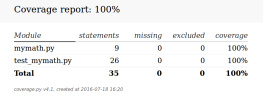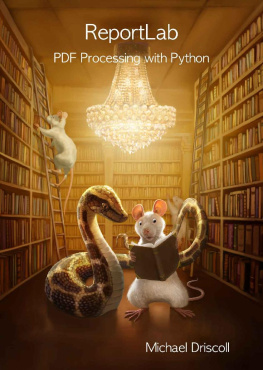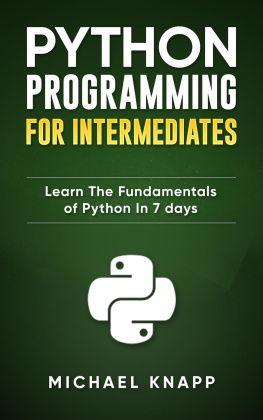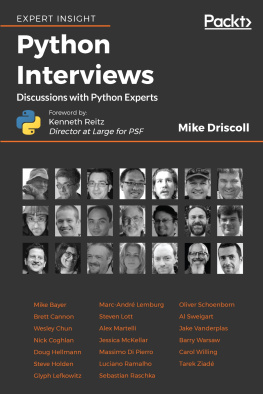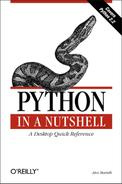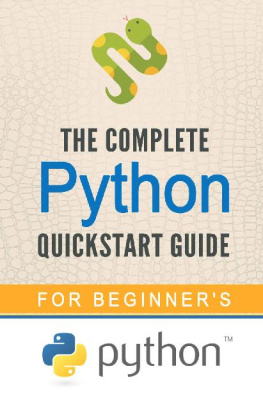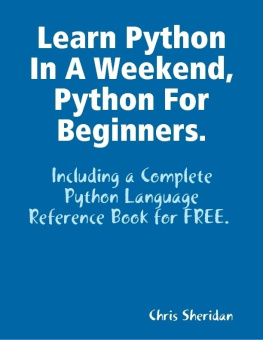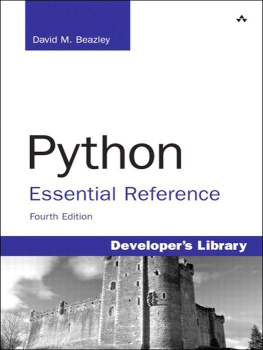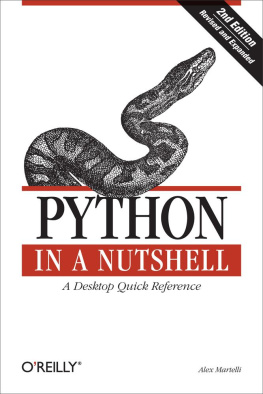Michael Driscoll - Python 101
Here you can read online Michael Driscoll - Python 101 full text of the book (entire story) in english for free. Download pdf and epub, get meaning, cover and reviews about this ebook. year: 2014, publisher: Michael Driscoll, genre: Computer. Description of the work, (preface) as well as reviews are available. Best literature library LitArk.com created for fans of good reading and offers a wide selection of genres:
Romance novel
Science fiction
Adventure
Detective
Science
History
Home and family
Prose
Art
Politics
Computer
Non-fiction
Religion
Business
Children
Humor
Choose a favorite category and find really read worthwhile books. Enjoy immersion in the world of imagination, feel the emotions of the characters or learn something new for yourself, make an fascinating discovery.

- Book:Python 101
- Author:
- Publisher:Michael Driscoll
- Genre:
- Year:2014
- Rating:5 / 5
- Favourites:Add to favourites
- Your mark:
- 100
- 1
- 2
- 3
- 4
- 5
Python 101: summary, description and annotation
We offer to read an annotation, description, summary or preface (depends on what the author of the book "Python 101" wrote himself). If you haven't found the necessary information about the book — write in the comments, we will try to find it.
Python 101 — read online for free the complete book (whole text) full work
Below is the text of the book, divided by pages. System saving the place of the last page read, allows you to conveniently read the book "Python 101" online for free, without having to search again every time where you left off. Put a bookmark, and you can go to the page where you finished reading at any time.
Font size:
Interval:
Bookmark:

This book is for sale at http://leanpub.com/python_101
This version was published on 2016-10-27
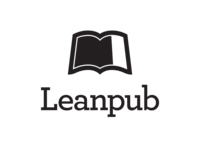
* * * * *
This is a Leanpub book. Leanpub empowers authors and publishers with the Lean Publishing process. Lean Publishing is the act of publishing an in-progress ebook using lightweight tools and many iterations to get reader feedback, pivot until you have the right book and build traction once you do.
* * * * *
Welcome to Python 101! I wrote this book to help you learn Python 3. Itis not meant to be an exhaustive reference book. Instead, the object isto get you acquainted with the building blocks of Python so that you canactually write something useful yourself. A lot of programming textbooksonly teach you the language, but do not go much beyond that. I willendeavour to not only get you up to speed on the basics, but also toshow you how to create useful programs. Now you may be wondering whyjust learning the basics isnt enough. In my experience, when I getfinished reading an introductory text, I want to then create something,but I dont know how! Ive got the learning, but not the glue to getfrom point A to point B. I think its important to not only teach youthe basics, but also cover intermediate material.
Thus, this book will be split into five parts:
- Part one will cover Pythons basics
- Part two will be on a small subset of Pythons Standard Library
- Part three will be intermediate material
- Part four will be a series of small tutorials
- Part five will cover Python packaging and distribution
|
Let me spend a few moments explaining what each part has to offer. Inpart one, we will cover the following:
- Python types (strings, lists, dicts, etc)
- Conditional statements
- Loops
- List and dictionary comprehensions
- Exception Handling
- File I/O
- Functions and Classes
|
Part two will talk about some of Pythons standard library. The standardlibrary is what comes pre-packaged with Python. It is made up of modulesthat you can import to get added functionality. For example, you canimport the math module to gain some high level math functions. Iwill be cherry picking the modules I use the most as a day-to-dayprofessional and explaining how they work. The reason I think this is agood idea is that they are common, every day modules that I think youwill benefit knowing about at the beginning of your Python education.This section will also cover various ways to install 3rd party modules.Finally, I will cover how to create your own modules and packages andwhy youd want to do that in the first place. Here are some of themodules we will be covering:
- csv
- ConfigParser
- logging
- os
- smtplib / email
- subprocess
- sys
- thread / queues
- time / datetime
|
Part three will cover intermediate odds and ends. These are topics thatare handy to know, but not necessarily required to be able to program inPython. The topics covered are:
- the Python debugger (pdb)
- decorators
- the lambda function
- code profiling
- a testing introduction
|
Part four will be made up of small tutorials that will help you to learnhow to use Python in a practical way. In this way, you will learn how tocreate Python programs that can actually do something useful! You cantake the knowledge in these tutorials to create your own scripts. Ideasfor further enhancements to these mini-applications will be provided atthe end of each tutorial so you will have something that you can try outon your own. Here are a few of the 3rd party packages that well becovering:
- pip and easy_install
- configobj
- lxml
- requests
- virtualenv
- pylint / pychecker
- SQLAlchemy
|
Part five is going to cover how to take your code and give it to yourfriends, family and the world! You will learn the following:
- How to turn your reusable scripts into Python eggs, wheels andmore
- How to upload your creation to the Python Package Index (PyPI)
- How to create binary executables so you can run your applicationwithout Python
- How to create an installer for your application
|
The chapters and sections may not all be the same length. While everytopic will be covered well, not every topic will require the same pagecount.
I think it helps to know the background of the Python programminglanguage. Python was created in the late1980s. Everyone agrees thatits creator is Guido van Rossum when he wrote it as a successor to theABC programming language that he was using. Guido named the languageafter one of his favorite comedy acts: Monty Python. The language wasntreleased until 1991 and it has grown a lot in terms of the number ofincluded modules and packages included. At the time of this writing,there are two major versions of Python: the 2.x series and the 3.x(sometimes known as Python 3000) . The 3.x series is not backwardscompatible with 2.x because the idea when creating 3.x was to get rid ofsome of the idiosyncrasies in the original. The current versions are2.7.12 and 3.5.2. Most of the features in 3.x have been backported to2.x; however, 3.x is getting the majority of Pythons currentdevelopment, so it is the version of the future.
Some people think Python is just for writing little scripts to gluetogether real code, like C++ or Haskell. However you will find Pythonto be useful in almost any situation. Python is used by lots of big namecompanies such as Google, NASA, LinkedIn, Industrial Light & Magic, andmany others. Python is used not only on the backend, but also on thefront. In case youre new to the computer science field, backendprogramming is the stuff thats behind the scenes; things like databaseprocessing, document generation, etc. Frontend processing is the prettystuff most users are familiar with, such as web pages or desktop userinterfaces. For example, there are some really nice Python GUI toolkitssuch as wxPython, PySide, and Kivy. There are also several webframeworks like Django, Pyramid, and Flask. You might find it surprisingto know that Django is used for Instagram and Pinterest. If you haveused these or many other websites, then you have used something thatspowered by Python without even realizing it!
You may be wondering about who I am and why I might be knowledgeableenough about Python to write about it, so I thought Id give you alittle information about myself. I started programming in Python in theSpring of 2006 for a job. My first assignment was to port Windows loginscripts from Kixtart to Python. My second project was to port VBA code(basically a GUI on top of Microsoft Office products) to Python, whichis how I first got started in wxPython. Ive been using Python eversince, doing a variation of backend programming and desktop front enduser interfaces.
I realized that one way for me to remember how to do certain things inPython was to write about them and thats how my Python blog came about:http://www.blog.pythonlibrary.org/. As I wrote, I would receivefeedback from my readers and I ended up expanding the blog to includetips, tutorials, Python news, and Python book reviews. I work regularlywith Packt Publishing as a technical reviewer, which means that I get totry to check for errors in the books before theyre published. I alsohave written for the Developer Zone (DZone) and i-programmer websites aswell as the Python Software Foundation. In November 2013, DZonepublished
Font size:
Interval:
Bookmark:
Similar books «Python 101»
Look at similar books to Python 101. We have selected literature similar in name and meaning in the hope of providing readers with more options to find new, interesting, not yet read works.
Discussion, reviews of the book Python 101 and just readers' own opinions. Leave your comments, write what you think about the work, its meaning or the main characters. Specify what exactly you liked and what you didn't like, and why you think so.

